Topic 09 建筑艺术-2025年初中英语中考传统文化阅读与写作专练(话题解读+文化拓展+文化拓展)
文档属性
| 名称 | Topic 09 建筑艺术-2025年初中英语中考传统文化阅读与写作专练(话题解读+文化拓展+文化拓展) |
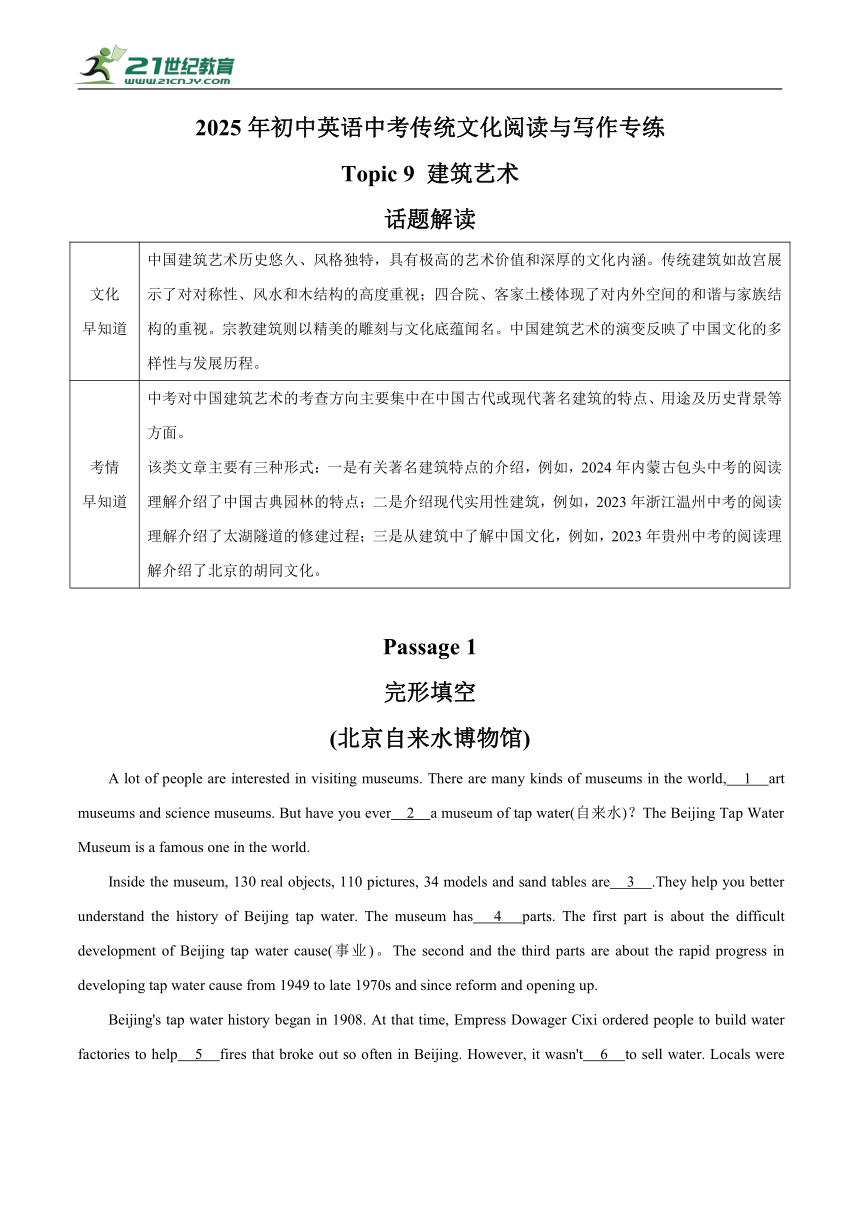
|
|
| 格式 | docx | ||
| 文件大小 | 180.5KB | ||
| 资源类型 | 试卷 | ||
| 版本资源 | 人教新目标(Go for it)版 | ||
| 科目 | 英语 | ||
| 更新时间 | 2025-04-09 09:07:56 | ||
图片预览

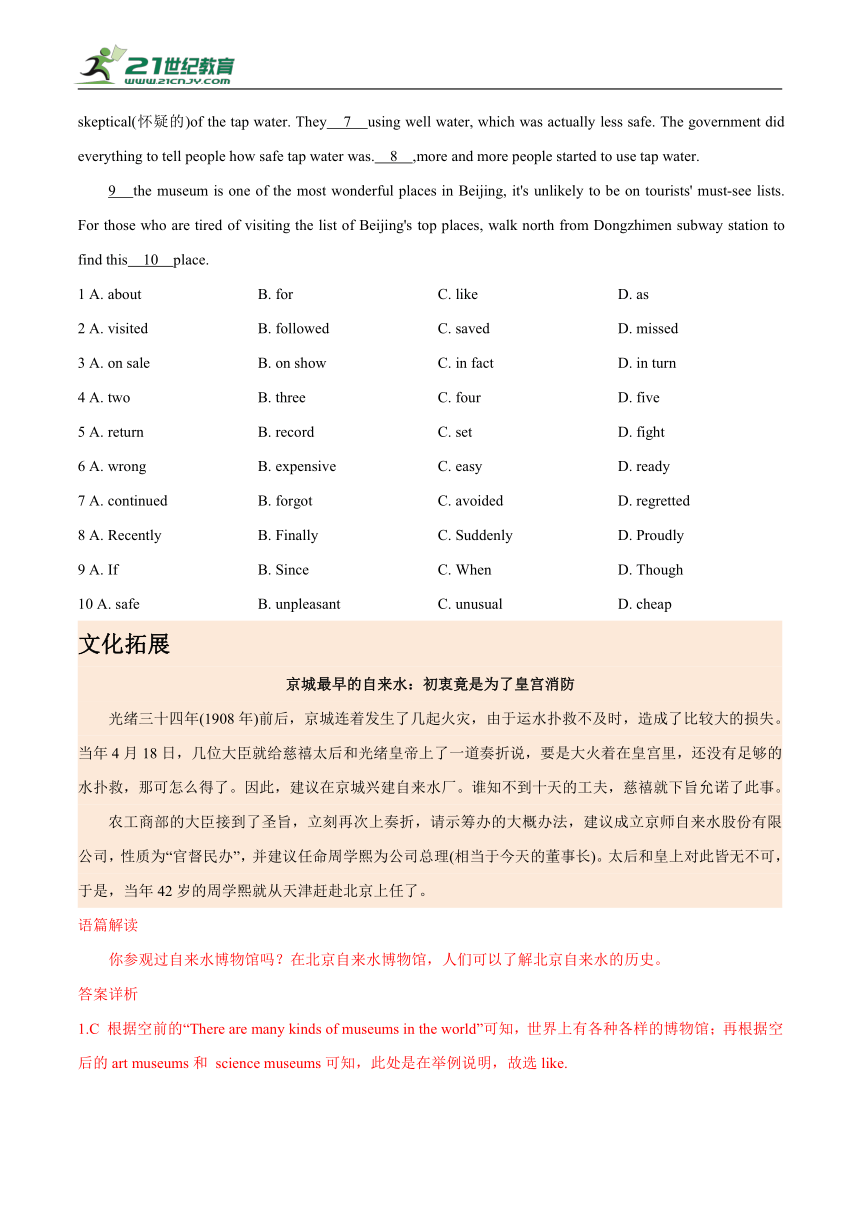
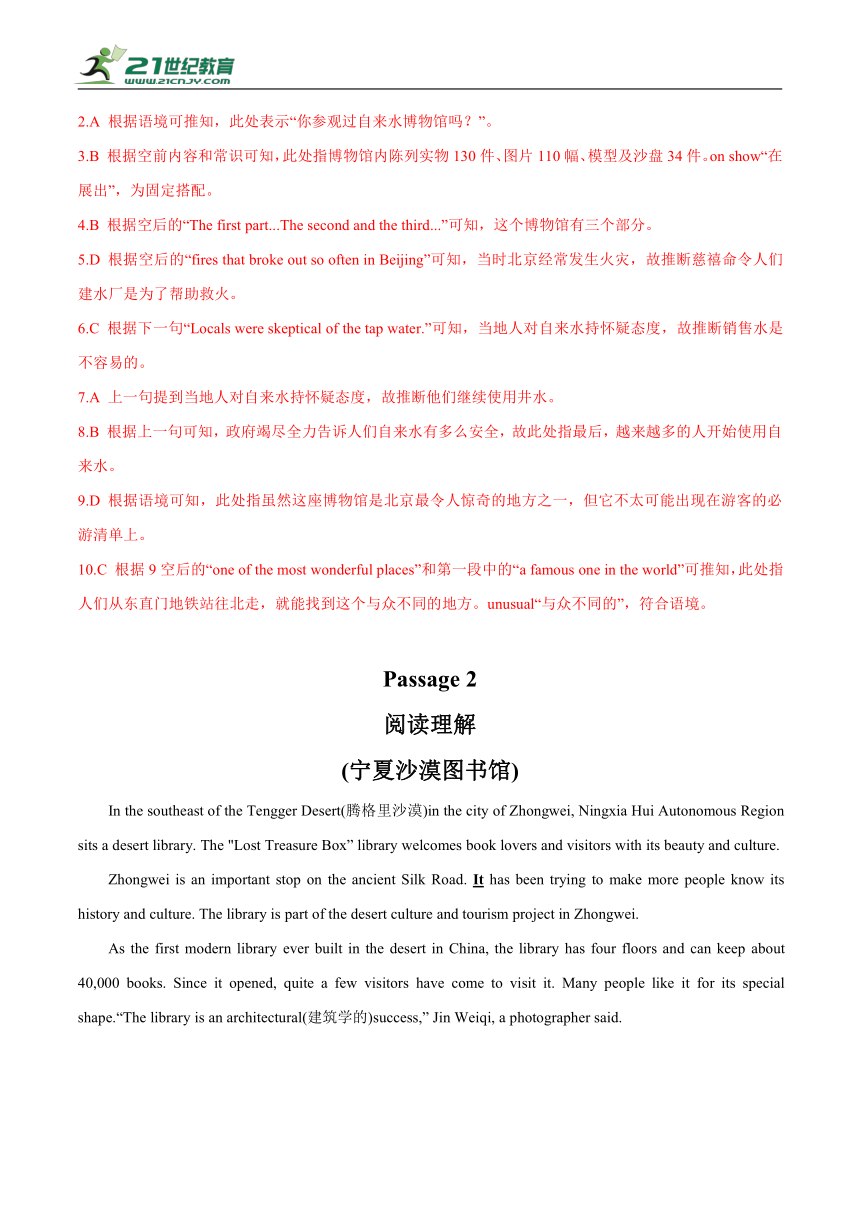
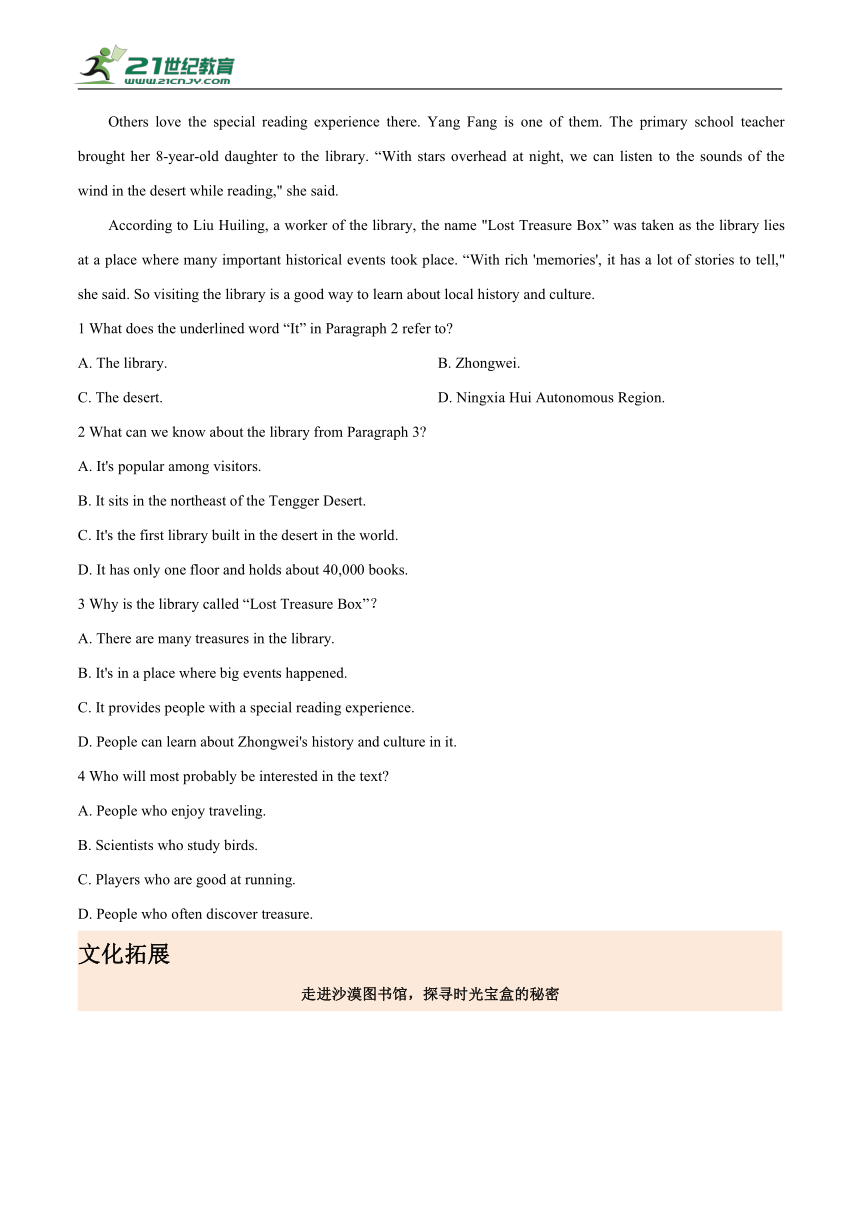
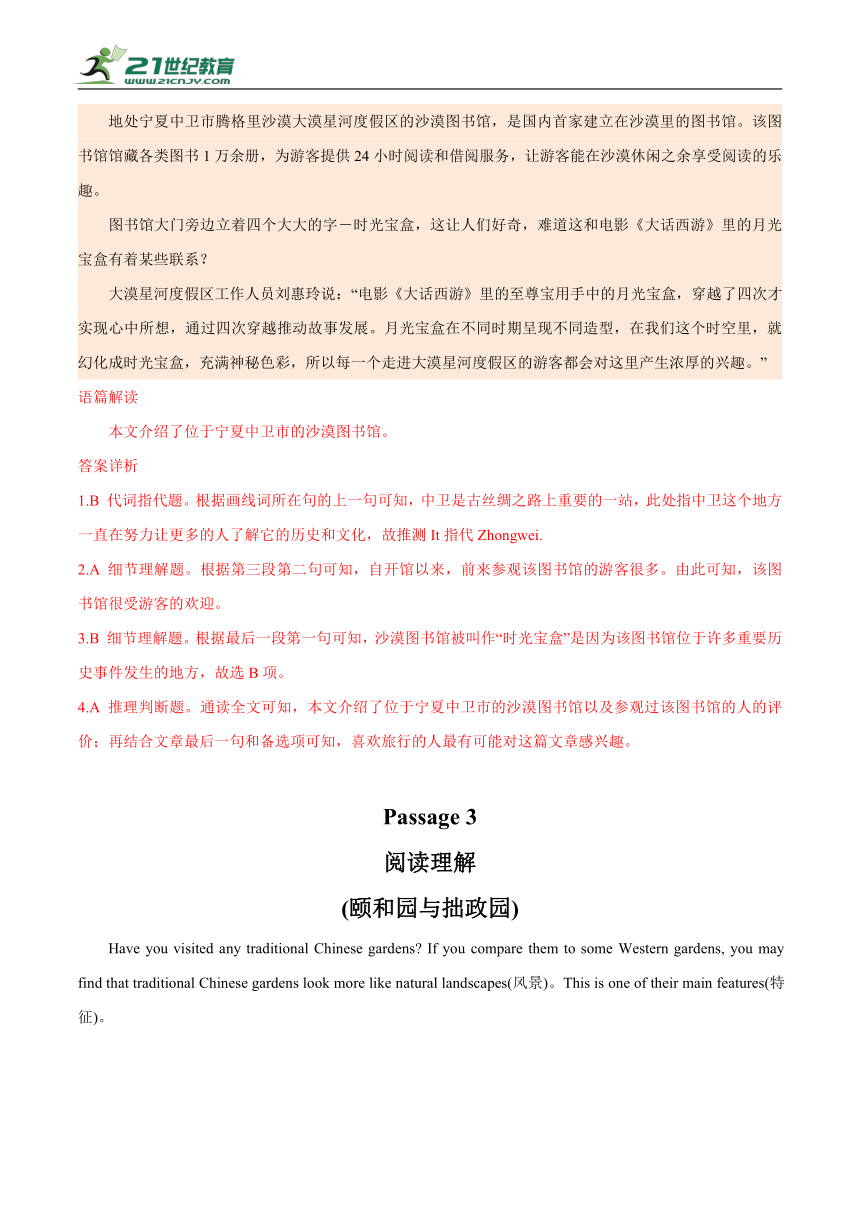
文档简介
2025年初中英语中考传统文化阅读与写作专练
Topic 9 建筑艺术
话题解读
文化
早知道
中国建筑艺术历史悠久、风格独特,具有极高的艺术价值和深厚的文化内涵。传统建筑如故宫展示了对对称性、风水和木结构的高度重视;四合院、客家土楼体现了对内外空间的和谐与家族结构的重视。宗教建筑则以精美的雕刻与文化底蕴闻名。中国建筑艺术的演变反映了中国文化的多样性与发展历程。
考情
早知道
中考对中国建筑艺术的考查方向主要集中在中国古代或现代著名建筑的特点、用途及历史背景等方面。
该类文章主要有三种形式:一是有关著名建筑特点的介绍,例如,2024年内蒙古包头中考的阅读理解介绍了中国古典园林的特点;二是介绍现代实用性建筑,例如,2023年浙江温州中考的阅读理解介绍了太湖隧道的修建过程;三是从建筑中了解中国文化,例如,2023年贵州中考的阅读理解介绍了北京的胡同文化。
Passage 1
完形填空
(北京自来水博物馆)
A lot of people are interested in visiting museums. There are many kinds of museums in the world, 1 art museums and science museums. But have you ever 2 a museum of tap water(自来水)?The Beijing Tap Water Museum is a famous one in the world.
Inside the museum, 130 real objects, 110 pictures, 34 models and sand tables are 3 .They help you better understand the history of Beijing tap water. The museum has 4 parts. The first part is about the difficult development of Beijing tap water cause(事业)。The second and the third parts are about the rapid progress in developing tap water cause from 1949 to late 1970s and since reform and opening up.
Beijing's tap water history began in 1908. At that time, Empress Dowager Cixi ordered people to build water factories to help 5 fires that broke out so often in Beijing. However, it wasn't 6 to sell water. Locals were skeptical(怀疑的)of the tap water. They 7 using well water, which was actually less safe. The government did everything to tell people how safe tap water was. 8 ,more and more people started to use tap water.
9 the museum is one of the most wonderful places in Beijing, it's unlikely to be on tourists' must-see lists. For those who are tired of visiting the list of Beijing's top places, walk north from Dongzhimen subway station to find this 10 place.
1 A. about
B. for
C. like
D. as
2 A. visited
B. followed
C. saved
D. missed
3 A. on sale
B. on show
C. in fact
D. in turn
4 A. two
B. three
C. four
D. five
5 A. return
B. record
C. set
D. fight
6 A. wrong
B. expensive
C. easy
D. ready
7 A. continued
B. forgot
C. avoided
D. regretted
8 A. Recently
B. Finally
C. Suddenly
D. Proudly
9 A. If
B. Since
C. When
D. Though
10 A. safe
B. unpleasant
C. unusual
D. cheap
文化拓展
京城最早的自来水:初衷竟是为了皇宫消防
光绪三十四年(1908年)前后,京城连着发生了几起火灾,由于运水扑救不及时,造成了比较大的损失。当年4月18日,几位大臣就给慈禧太后和光绪皇帝上了一道奏折说,要是大火着在皇宫里,还没有足够的水扑救,那可怎么得了。因此,建议在京城兴建自来水厂。谁知不到十天的工夫,慈禧就下旨允诺了此事。
农工商部的大臣接到了圣旨,立刻再次上奏折,请示筹办的大概办法,建议成立京师自来水股份有限公司,性质为“官督民办”,并建议任命周学熙为公司总理(相当于今天的董事长)。太后和皇上对此皆无不可,于是,当年42岁的周学熙就从天津赶赴北京上任了。
语篇解读
你参观过自来水博物馆吗?在北京自来水博物馆,人们可以了解北京自来水的历史。
答案详析
1.C 根据空前的“There are many kinds of museums in the world”可知,世界上有各种各样的博物馆;再根据空后的art museums和 science museums可知,此处是在举例说明,故选like.
2.A 根据语境可推知,此处表示“你参观过自来水博物馆吗?”。
3.B 根据空前内容和常识可知,此处指博物馆内陈列实物130件、图片110幅、模型及沙盘34件。on show“在展出”,为固定搭配。
4.B 根据空后的“The first part...The second and the third...”可知,这个博物馆有三个部分。
5.D 根据空后的“fires that broke out so often in Beijing”可知,当时北京经常发生火灾,故推断慈禧命令人们建水厂是为了帮助救火。
6.C 根据下一句“Locals were skeptical of the tap water.”可知,当地人对自来水持怀疑态度,故推断销售水是不容易的。
7.A 上一句提到当地人对自来水持怀疑态度,故推断他们继续使用井水。
8.B 根据上一句可知,政府竭尽全力告诉人们自来水有多么安全,故此处指最后,越来越多的人开始使用自来水。
9.D 根据语境可知,此处指虽然这座博物馆是北京最令人惊奇的地方之一,但它不太可能出现在游客的必游清单上。
10.C 根据9空后的“one of the most wonderful places”和第一段中的“a famous one in the world”可推知,此处指人们从东直门地铁站往北走,就能找到这个与众不同的地方。unusual“与众不同的”,符合语境。
Passage 2
阅读理解
(宁夏沙漠图书馆)
In the southeast of the Tengger Desert(腾格里沙漠)in the city of Zhongwei, Ningxia Hui Autonomous Region sits a desert library. The "Lost Treasure Box” library welcomes book lovers and visitors with its beauty and culture.
Zhongwei is an important stop on the ancient Silk Road. It has been trying to make more people know its history and culture. The library is part of the desert culture and tourism project in Zhongwei.
As the first modern library ever built in the desert in China, the library has four floors and can keep about 40,000 books. Since it opened, quite a few visitors have come to visit it. Many people like it for its special shape.“The library is an architectural(建筑学的)success,” Jin Weiqi, a photographer said.
Others love the special reading experience there. Yang Fang is one of them. The primary school teacher brought her 8-year-old daughter to the library. “With stars overhead at night, we can listen to the sounds of the wind in the desert while reading," she said.
According to Liu Huiling, a worker of the library, the name "Lost Treasure Box” was taken as the library lies at a place where many important historical events took place. “With rich 'memories', it has a lot of stories to tell," she said. So visiting the library is a good way to learn about local history and culture.
1 What does the underlined word “It” in Paragraph 2 refer to?
A. The library.
B. Zhongwei.
C. The desert.
D. Ningxia Hui Autonomous Region.
2 What can we know about the library from Paragraph 3?
A. It's popular among visitors.
B. It sits in the northeast of the Tengger Desert.
C. It's the first library built in the desert in the world.
D. It has only one floor and holds about 40,000 books.
3 Why is the library called “Lost Treasure Box”?
A. There are many treasures in the library.
B. It's in a place where big events happened.
C. It provides people with a special reading experience.
D. People can learn about Zhongwei's history and culture in it.
4 Who will most probably be interested in the text?
A. People who enjoy traveling.
B. Scientists who study birds.
C. Players who are good at running.
D. People who often discover treasure.
文化拓展
走进沙漠图书馆,探寻时光宝盒的秘密
地处宁夏中卫市腾格里沙漠大漠星河度假区的沙漠图书馆,是国内首家建立在沙漠里的图书馆。该图书馆馆藏各类图书1万余册,为游客提供24小时阅读和借阅服务,让游客能在沙漠休闲之余享受阅读的乐趣。
图书馆大门旁边立着四个大大的字-时光宝盒,这让人们好奇,难道这和电影《大话西游》里的月光宝盒有着某些联系?
大漠星河度假区工作人员刘惠玲说:“电影《大话西游》里的至尊宝用手中的月光宝盒,穿越了四次才实现心中所想,通过四次穿越推动故事发展。月光宝盒在不同时期呈现不同造型,在我们这个时空里,就幻化成时光宝盒,充满神秘色彩,所以每一个走进大漠星河度假区的游客都会对这里产生浓厚的兴趣。”
语篇解读
本文介绍了位于宁夏中卫市的沙漠图书馆。
答案详析
1.B 代词指代题。根据画线词所在句的上一句可知,中卫是古丝绸之路上重要的一站,此处指中卫这个地方一直在努力让更多的人了解它的历史和文化,故推测It指代Zhongwei.
2.A 细节理解题。根据第三段第二句可知,自开馆以来,前来参观该图书馆的游客很多。由此可知,该图书馆很受游客的欢迎。
3.B 细节理解题。根据最后一段第一句可知,沙漠图书馆被叫作“时光宝盒”是因为该图书馆位于许多重要历史事件发生的地方,故选B项。
4.A 推理判断题。通读全文可知,本文介绍了位于宁夏中卫市的沙漠图书馆以及参观过该图书馆的人的评价;再结合文章最后一句和备选项可知,喜欢旅行的人最有可能对这篇文章感兴趣。
Passage 3
阅读理解
(颐和园与拙政园)
Have you visited any traditional Chinese gardens? If you compare them to some Western gardens, you may find that traditional Chinese gardens look more like natural landscapes(风景)。This is one of their main features(特征)。
Chinese gardens have a long history. As early as 1500 BC, there were two main types of gardens: imperial gardens and private gardens. Imperial gardens were for the emperor and his family. Private gardens were built by general nobles(贵族)。Both types of gardens were built for hunting and resting.
The Summer Palace in Beijing is China's famous imperial garden. It covers about three million square meters. Kunming Lake takes up almost three-fourths of the garden's total area. There are over 3,000 ancient buildings and more than 1,600 ancient and famous trees in the garden. You can also see a large number of priceless historical treasures. With such a rich collection, the Summer Palace is known as the “Imperial Garden Museum”。
As for private gardens, the most famous one is the Humble Administrator's Garden(拙政园)in Suzhou. It has an area of about 52,000 square meters. The garden has a delicate design. It looks like a beautiful picture when people stand in the garden, viewing it from any angle(角度)。And the whole garden looks different in different seasons.
In fact, Chinese gardens are in some ways like traditional Chinese landscape paintings. The two have influenced and developed each other. Both of them show the importance of nature in Chinese culture.
1 What do we know about imperial gardens and private gardens?
A. They are very similar in size and style.
B. They were built for hunting and resting.
C. They look the same in different seasons.
D. They were for the use of general nobles.
2 How does the writer describe the Summer Palace?
A. By listing numbers.
B. By answering questions.
C. By comparing facts.
D. By giving examples.
3 The underlined word “delicate" in Paragraph 4 probably means “
A.精致的-B.现代的-C.简单的-D.基本的
4 What's the writer's main purpose of writing the text?
A. To show the beauty of natural landscapes.
B. To encourage people to visit private gardens.
C. To introduce traditional Chinese gardens.
D. To advise people to protect ancient buildings.
文化拓展
中国皇家园林之瑰宝-颐和园
颐和园,前身为清漪园,中国清朝时期皇家园林,坐落在北京西郊,与圆明园毗邻。颐和园是以昆明湖、万寿山为基址,以杭州西湖为蓝本,汲取江南园林的设计手法而建成的一座大型山水园林,也是保存最完整的皇家行宫御苑之一,被誉为“皇家园林博物馆”。
据史料记载,慈禧太后晚年时,大概是太过迷恋颐和园的山水,拍摄了许多在颐和园中的生活照,其中有游园的、乘船赏荷花的,也有个人写真,还有与外国使节的合影,为颐和园留下了珍贵的人物风貌照。
颐和园中的每一处、每一季、每一时、每一刻,都散发着世界园林之最的独有魅力。即使严寒的冬天,连绵不断的峰峦仍披着绿装,色浓似染,空气清新,漫步其间,令人心旷神怡,流连忘返。
语篇解读
本文主要介绍了中国的两个园林:皇家园林代表颐和园和私家园林代表拙政园。
答案详析
1.B 细节理解题。根据第二段最后一句“Both types of gardens were built for hunting and resting.”可知,皇家园林和私家园林都是为狩猎和休息而修建的。
2.A 推理判断题。根据第三段中的three million、three-fourths、3,000、1,600可知,作者主要是通过列数字的方式来描述颐和园的。
3.A 词义猜测题。根据画线词所在句的下一句可知,人们站在园中,从任何角度看它,它都像一幅美丽的图画。由此可推知,拙政园是非常精致的,故推测delicate意为“精致的”。
4.C 推理判断题。通读全文可知,本文主要介绍了中国的颐和园和拙政园,故C项是本文的写作目的。
Passage 4
阅读理解
(奥港澳大湾区世界级机场群)
China aims to finish the building of a world-class cluster(群)of airports in the Guangdong-Hong Kong-Macao Greater Bay Area by 2025. It will make a strong connection among the above three places and provide convenience for people in these areas.
According to a plan announced by the Civil Aviation Administration of China(CAAC,中国民用航空局),the civil aviation sector in the Greater Bay Area will continue to play a leading role worldwide by 2025. The plan also sets goals to be reached by 2035,when the area will be proud of an excellent world-class airport cluster that is safe, green and smart.
Five main airports-Hong Kong International Airport, Guangzhou Baiyun International Airport, Shenzhen Bao'an International Airport, Macao International Airport and Zhuhai Jinwan Airport-and a series of small airports in the area will make up the airport cluster.
To meet the needs of the plan, main airports in the Greater Bay Area have sped up infrastructure expansion(基础设施扩建)and building projects in recent years.
Guangzhou Baiyun International Airport plans to finish its expansion by 2025,which mainly includes its fourth and fifth runways and a-third terminal(航站楼)。Zhuhai Jinwan Airport is also preparing to enlarge itself by 2027 by building its second 190,000-square-meter terminal...
1 What can we know from Paragraph 2?
A. How the world-class airport cluster will be built.
B. When the building of the Greater Bay Area is finished.
C. Why China plans to build a world-class airport cluster.
D. What the plan announced by CAAC wants to achieve by 2035.
2 The airport cluster doesn't include__________.
A. Taipei Songshan Airport
B. Macao International Airport
C. Hong Kong International Airport
D. Guangzhou Baiyun International Airport
3 Which of the following is TRUE about the plan?
A.A satellite(卫星)terminal will be built in Guangzhou.
B. Macao International Airport will build its fourth and fifth runways.
C. Zhuhai Jinwan Airport will build its second 190,000-square-meter terminal.
D. Guangzhou Baiyun International Airport plans to build its second terminal.
4 What's the main idea of the passage?
A. We have had the biggest airport cluster.
B. The Greater Bay Area airport cluster will be built.
C. Guangdong,Hong Kong and Macao share the same airport.
D. Guangzhou Baiyun International Airport will be enlarged.
文化拓展
粤港澳大湾区“世界级机场群”呼之欲出
粤港澳大湾区是中国开放程度最高、经济活力最强劲的区域之一,发展自然也离不开“交通先行”。目前,正在蓬勃发展的粤港澳大湾区,“陆海空”立体大通道越发畅通,“轨道上的大湾区”密织成网,“航线上的大湾区”通达全球。发达的航空运输能力和临空经济是世界级湾区的核心增长极之一。
建设世界级机场群,将为全面建成国际一流湾区发挥战略性、基础性作用。依托区域经济社会发展,以广州白云国际机场、香港国际机场、深圳宝安国际机场为引领的粤港澳大湾区机场群业务规模位居国内乃至全球机场群前列,未来发展潜力巨大。
语篇解读
粤港澳大湾区世界级机场群将于2025年基本建成,这将使粤港澳大湾区三地紧密相连,为人民生活提供便利。
答案详析
1.D 细节理解题。根据第二段可知,根据中国民用航空局公布的一项规划,到2025年,粤港澳大湾区民航持续保持国际领先。规划还设定了到2035年的目标,届时大湾区将拥有一个安全、绿色、智慧的世界级机场群。由此可知,D项符合题意。
2.A 细节理解题。根据第三段可知,香港国际机场、广州白云国际机场、深圳宝安国际机场、澳门国际机场和珠海金湾机场以及粤港澳大湾区内一系列小型机场将组成机场群。由此可知,大湾区机场群不包括台北松山机场。
3.C 细节理解题。根据最后一段最后一句可知,珠海金湾机场准备建设第二座19万平方米的航站楼。
4.B 主旨大意题。通读全文可知,本文主要介绍了将于2025年基本建成的粤港澳大湾区世界级机场群,故B项“大湾区机场群将建成”最符合本文主旨。
Passage 5
任务型阅读
(客家土楼)
Have you ever visited earth buildings? In the western part of Fujian province, there are groups of earth buildings. They are mainly built by the Hakka people of Fujian, so these buildings have been considered as symbols of Hakka culture. 1
Hakka Earth Buildings are famous for the long history, unusual style and smart structure(结构)。They are usually round and built on the flat(平坦的)place between mountains and hills. For most buildings, they face south with rivers on the left, roads on the right, ponds in front and hills at the back. 2
The buildings were built for defense(防御)at the beginning. 3 They were built between three and five stories high. There were no windows in the first and second stories. To prevent fire accidents, there was water and sand inside the buildings. 4 These buildings are so amazing that they were listed among the World Heritage List in 2008.
Today, the earth buildings are one of Fujian province's top tourist attractions. 5 The tourism has changed the local people's lives. Most of them are busy with tourism, instead of farming.
根据短文内容,从选项中选出能填入空白处的最佳选项。
A. Walls were as thick as one to two meters.
B. And we call them Hakka Earth Buildings.
C. More and more visitors come here to visit.
D. The location makes them comfortable places to live.
E. There was also an underground back gate for escaping(逃跑)。
1_________ 2_________ 3_________ 4_________ 5_________
文化拓展
客家人为什么会建造福建土楼?
福建土楼是以土作墙而建造起来的集体建筑,有着奇特的外形和内部构造,以规模宏大、设计科学、布局合理、保存完好闻名遐迩。它是中国民居建筑的瑰宝,是客家文化的一部动人史诗。
为什么客家人会想到建造土楼呢?客家先民经历战乱后南迁到宁静封闭的闽西地区,需要安定的环境休养生息和发展。福建地区多山,难以像平原地区般,一家一户各建四合院。建造规模庞大的土楼聚族而居、固守设防,不但可隔绝战乱动荡,也可有效保护客家先民辛苦赚来的粮食和财富。福建土楼与其说是民居,不如说是一座“家族之城”。
2008年,福建土楼被列入《世界遗产名录》。承载了客家人千年希望与梦想的土楼,跨越沧桑远古,走出大山,走向世界,正日益焕发出更加绚丽夺目的光彩。
语篇解读
本文介绍了福建客家人引以为傲的标志性建筑-客家土楼。
答案详析
1.B 根据空前一句可知,福建的土楼主要由客家人建造,因此被认为是客家文化的象征;再根据第二段第一句中的Hakka Earth Buildings可推知,空处内容应该引出客家土楼这一概念,故B项“并且我们将它们称作客家土楼”可承上启下,符合语境。
2.D 根据空前一句可知,大多数土楼面向南,左边是河流,右边是道路,前面是池塘,后面是山丘。此处介绍的是客家土楼的地理位置,故D项“这样的位置使它们成为舒适的居住地”可承接上文,符合语境。
3.A 根据空前一句可知,客家土楼最初是为了防御而建,故推测空处内容应与土楼的防御性有关,故A项“墙壁有一到两米厚”可承接上文,符合语境。
4.E 根据空前一句可知,为了预防火灾,楼里放置水和沙子。由此可推知,空处内容应该与土楼的安全性有关,故E项“还有一个地下后门可供逃生”可承接上文,符合语境。
5.C 根据空前一句可知,如今,土楼已成为福建最重要的旅游景点之一;空后一句又提到旅游业改变了当地人的生活。由此可推知,空处内容应和客家土楼推动旅游业发展有关,故C项“越来越多的游客来这里参观”可承上启下,符合语境。
Passage 6
短文填空
(南京夫子庙)
阅读短文,在空白处填入一个适当的词,或填入括号中所给单词的正确形式。
Nanjing Confucius Temple lies on the north bank of the Qinhuai River in Nanjing. It was built in 1034 to show respect(尊敬)for Confucius, who was a great 1 (think) and educator. The temple was also a school and people considered it 2 a cultural center in old times.
The whole temple 3 (cover) a large area and comprises(由······组成)a group of old buildings. Among 4 (they), Gongyuan used to be a place for examinations, which was built in the Song Dynasty to choose officials.
Now the temple has turned into a popular place for traveling. Thousands of tourists come here 5 (pay)a visit. They can not only know much about history, but also learn Confucius' great ideas on education. Visiting the temple at night will give visitors a 6 (complete) different feeling. It's wonderful to take a boat on the Qinhuai River. The water looks 7 (beautiful) than usual as the sun goes down. So do the old buildings because they are all lit up by lanterns. What 8 nice thing to remember Confucius and recite(背诵)his sayings on the boat!
The temple holds many cultural 9 (activity) during festivals. Tourists can experience traditional Chinese arts, like paper-cutting and piyingxi. Besides, there are many kinds of Nanjing dishes and snacks. 10 you go there, why not have a try?
1_________ 2_________ 3_________ 4_________ 5_________
6_________ 7_________ 8_________ 9_________ 10_________
文化拓展
“天下文枢”南京夫子庙
六朝古都,十朝都会,南京拥有丰厚的文化积淀和独特的人文景观。南京夫子庙是南京这座城市的一张重要名片,其位于南京市秦淮区秦淮河北岸贡院街、江南贡院以西,主要由孔庙、学宫、贡院三大建筑群组成,自古便是街、景、河一体,为供奉祭祀孔子之地,是中国四大文庙之一。
南京夫子庙是中国第一历史文化名河“十里秦淮”最繁华、最精彩、最有韵味的核心区域。千年来,数百位名人雅士在这里写下传诵千古的篇章,故有“六朝金粉”之说,是中国最大的传统古街市。每年的春节至元宵节期间,夫子庙还会举行秦淮灯会,又称“金陵灯会”,是流传于南京地区的特色民俗文化活动。游客在这里品一味小吃,乘一次画舫,看秦淮河碧波光影,见证着历史与商业的繁华交融。
语篇解读
南京夫子庙坐落于南京市秦淮河畔,不仅是一座供奉祭祀孔子的庙宇,更是中国文化史上的一颗璀璨明珠。每当夜幕降临,灯火阑珊,夫子庙更显其独特的韵味与魅力。
答案详析
1.thinker 此处指孔子是一位伟大的思想家和教育家。所填词与空后的educator并列,故应用think的名词形式。thinker“思想家”为可数名词,且空前有不定冠词a修饰,故填thinker.
2.as 根据语境可知,此处指在古代,南京夫子庙也是一座学院,人们将其视为一个文化中心。consider...as...意为“把·····视作·····”,为固定搭配,故填as.
3.covers 整座庙占地面积很大,由古老的建筑群组成。空处缺少谓语动词,且此处描述的是客观事实,应用一般现在时;句子主语The whole temple为第三人称单数,故填covers.
4.them 其中,贡院曾是科举之地,建于宋代,是选拔官员的地方。空前的介词Among提示此处应用宾格,故填them.
5.to pay 成千上万的游客前来参观。分析句子结构可知,此处应用不定式表目的,故填to pay.
6.completely 夜访夫子庙会给游客一种截然不同的感觉。所填词修饰形容词different,故应填complete的副词形式completely.
7.more beautiful 根据空后的“than usual as the sun goes down”可知,夕阳西下时,水面看起来比往常更美丽。空前的looks和空后的than提示此处应用形容词的比较级,故填more beautiful.
8.a在船上缅怀孔子,背诵他的名言,是一件多么美好的事情啊!此处表泛指,空后的thing为可数名词单数形式,且nice以辅音音素开头,故填不定冠词a.
9.activities 在节日期间,夫子庙会举办许多文化活动。activity为可数名词,且空前有many修饰,故填其复数形式activities.
10.If/When 分析句子结构可知,空处缺少连词。此处可以用if引导条件状语从句,表示“如果你去那里,为什么不试一下?”;也可以用when引导时间状语从句,表示“当你去那里时,为什么不试一下呢?”,故填If或When.注意首字母大写。
Passage 7
书面表达
(记录中国茶叶博物馆的所见所闻)
假设你是李华,请你根据下表,写一篇日记,描述你在中国茶叶博物馆的所见所闻。
Our Trip to China National Tea Museum
Time: August 5th,Monday Weather: cloudy People: my family and I
Activities:①learn information about... ②see so many kinds of tea③learn how to make tea ④...
Feelings:...
注意:
1.必须包括方框中的所有要点,可适当发挥;
2.文中不得出现真实的人名、校名等信息;
3.词数:80~100.
August 5th, Monday Cloudy
____________________________________________________________________________________________
____________________________________________________________________________________________
____________________________________________________________________________________________
____________________________________________________________________________________________
____________________________________________________________________________________________
____________________________________________________________________________________________
____________________________________________________________________________________________
____________________________________________________________________________________________
参考范文:
August 5th,Monday Cloudy
My family and I went to China National Tea Museum today. It is one of the most interesting museums that I've ever been to. At the museum, I learned some information about the history of tea. When I saw so many kinds of tea, I just couldn't believe my eyes. I also learned how to make tea. Later, I watched a tea art performance. It was enjoyable to watch the tea preparation while drinking tea.
How amazing! I've finally realized why my grandpa loves drinking tea so much! It's a wonderful experience and I will pass on our traditional tea culture.
Topic 9 建筑艺术
话题解读
文化
早知道
中国建筑艺术历史悠久、风格独特,具有极高的艺术价值和深厚的文化内涵。传统建筑如故宫展示了对对称性、风水和木结构的高度重视;四合院、客家土楼体现了对内外空间的和谐与家族结构的重视。宗教建筑则以精美的雕刻与文化底蕴闻名。中国建筑艺术的演变反映了中国文化的多样性与发展历程。
考情
早知道
中考对中国建筑艺术的考查方向主要集中在中国古代或现代著名建筑的特点、用途及历史背景等方面。
该类文章主要有三种形式:一是有关著名建筑特点的介绍,例如,2024年内蒙古包头中考的阅读理解介绍了中国古典园林的特点;二是介绍现代实用性建筑,例如,2023年浙江温州中考的阅读理解介绍了太湖隧道的修建过程;三是从建筑中了解中国文化,例如,2023年贵州中考的阅读理解介绍了北京的胡同文化。
Passage 1
完形填空
(北京自来水博物馆)
A lot of people are interested in visiting museums. There are many kinds of museums in the world, 1 art museums and science museums. But have you ever 2 a museum of tap water(自来水)?The Beijing Tap Water Museum is a famous one in the world.
Inside the museum, 130 real objects, 110 pictures, 34 models and sand tables are 3 .They help you better understand the history of Beijing tap water. The museum has 4 parts. The first part is about the difficult development of Beijing tap water cause(事业)。The second and the third parts are about the rapid progress in developing tap water cause from 1949 to late 1970s and since reform and opening up.
Beijing's tap water history began in 1908. At that time, Empress Dowager Cixi ordered people to build water factories to help 5 fires that broke out so often in Beijing. However, it wasn't 6 to sell water. Locals were skeptical(怀疑的)of the tap water. They 7 using well water, which was actually less safe. The government did everything to tell people how safe tap water was. 8 ,more and more people started to use tap water.
9 the museum is one of the most wonderful places in Beijing, it's unlikely to be on tourists' must-see lists. For those who are tired of visiting the list of Beijing's top places, walk north from Dongzhimen subway station to find this 10 place.
1 A. about
B. for
C. like
D. as
2 A. visited
B. followed
C. saved
D. missed
3 A. on sale
B. on show
C. in fact
D. in turn
4 A. two
B. three
C. four
D. five
5 A. return
B. record
C. set
D. fight
6 A. wrong
B. expensive
C. easy
D. ready
7 A. continued
B. forgot
C. avoided
D. regretted
8 A. Recently
B. Finally
C. Suddenly
D. Proudly
9 A. If
B. Since
C. When
D. Though
10 A. safe
B. unpleasant
C. unusual
D. cheap
文化拓展
京城最早的自来水:初衷竟是为了皇宫消防
光绪三十四年(1908年)前后,京城连着发生了几起火灾,由于运水扑救不及时,造成了比较大的损失。当年4月18日,几位大臣就给慈禧太后和光绪皇帝上了一道奏折说,要是大火着在皇宫里,还没有足够的水扑救,那可怎么得了。因此,建议在京城兴建自来水厂。谁知不到十天的工夫,慈禧就下旨允诺了此事。
农工商部的大臣接到了圣旨,立刻再次上奏折,请示筹办的大概办法,建议成立京师自来水股份有限公司,性质为“官督民办”,并建议任命周学熙为公司总理(相当于今天的董事长)。太后和皇上对此皆无不可,于是,当年42岁的周学熙就从天津赶赴北京上任了。
语篇解读
你参观过自来水博物馆吗?在北京自来水博物馆,人们可以了解北京自来水的历史。
答案详析
1.C 根据空前的“There are many kinds of museums in the world”可知,世界上有各种各样的博物馆;再根据空后的art museums和 science museums可知,此处是在举例说明,故选like.
2.A 根据语境可推知,此处表示“你参观过自来水博物馆吗?”。
3.B 根据空前内容和常识可知,此处指博物馆内陈列实物130件、图片110幅、模型及沙盘34件。on show“在展出”,为固定搭配。
4.B 根据空后的“The first part...The second and the third...”可知,这个博物馆有三个部分。
5.D 根据空后的“fires that broke out so often in Beijing”可知,当时北京经常发生火灾,故推断慈禧命令人们建水厂是为了帮助救火。
6.C 根据下一句“Locals were skeptical of the tap water.”可知,当地人对自来水持怀疑态度,故推断销售水是不容易的。
7.A 上一句提到当地人对自来水持怀疑态度,故推断他们继续使用井水。
8.B 根据上一句可知,政府竭尽全力告诉人们自来水有多么安全,故此处指最后,越来越多的人开始使用自来水。
9.D 根据语境可知,此处指虽然这座博物馆是北京最令人惊奇的地方之一,但它不太可能出现在游客的必游清单上。
10.C 根据9空后的“one of the most wonderful places”和第一段中的“a famous one in the world”可推知,此处指人们从东直门地铁站往北走,就能找到这个与众不同的地方。unusual“与众不同的”,符合语境。
Passage 2
阅读理解
(宁夏沙漠图书馆)
In the southeast of the Tengger Desert(腾格里沙漠)in the city of Zhongwei, Ningxia Hui Autonomous Region sits a desert library. The "Lost Treasure Box” library welcomes book lovers and visitors with its beauty and culture.
Zhongwei is an important stop on the ancient Silk Road. It has been trying to make more people know its history and culture. The library is part of the desert culture and tourism project in Zhongwei.
As the first modern library ever built in the desert in China, the library has four floors and can keep about 40,000 books. Since it opened, quite a few visitors have come to visit it. Many people like it for its special shape.“The library is an architectural(建筑学的)success,” Jin Weiqi, a photographer said.
Others love the special reading experience there. Yang Fang is one of them. The primary school teacher brought her 8-year-old daughter to the library. “With stars overhead at night, we can listen to the sounds of the wind in the desert while reading," she said.
According to Liu Huiling, a worker of the library, the name "Lost Treasure Box” was taken as the library lies at a place where many important historical events took place. “With rich 'memories', it has a lot of stories to tell," she said. So visiting the library is a good way to learn about local history and culture.
1 What does the underlined word “It” in Paragraph 2 refer to?
A. The library.
B. Zhongwei.
C. The desert.
D. Ningxia Hui Autonomous Region.
2 What can we know about the library from Paragraph 3?
A. It's popular among visitors.
B. It sits in the northeast of the Tengger Desert.
C. It's the first library built in the desert in the world.
D. It has only one floor and holds about 40,000 books.
3 Why is the library called “Lost Treasure Box”?
A. There are many treasures in the library.
B. It's in a place where big events happened.
C. It provides people with a special reading experience.
D. People can learn about Zhongwei's history and culture in it.
4 Who will most probably be interested in the text?
A. People who enjoy traveling.
B. Scientists who study birds.
C. Players who are good at running.
D. People who often discover treasure.
文化拓展
走进沙漠图书馆,探寻时光宝盒的秘密
地处宁夏中卫市腾格里沙漠大漠星河度假区的沙漠图书馆,是国内首家建立在沙漠里的图书馆。该图书馆馆藏各类图书1万余册,为游客提供24小时阅读和借阅服务,让游客能在沙漠休闲之余享受阅读的乐趣。
图书馆大门旁边立着四个大大的字-时光宝盒,这让人们好奇,难道这和电影《大话西游》里的月光宝盒有着某些联系?
大漠星河度假区工作人员刘惠玲说:“电影《大话西游》里的至尊宝用手中的月光宝盒,穿越了四次才实现心中所想,通过四次穿越推动故事发展。月光宝盒在不同时期呈现不同造型,在我们这个时空里,就幻化成时光宝盒,充满神秘色彩,所以每一个走进大漠星河度假区的游客都会对这里产生浓厚的兴趣。”
语篇解读
本文介绍了位于宁夏中卫市的沙漠图书馆。
答案详析
1.B 代词指代题。根据画线词所在句的上一句可知,中卫是古丝绸之路上重要的一站,此处指中卫这个地方一直在努力让更多的人了解它的历史和文化,故推测It指代Zhongwei.
2.A 细节理解题。根据第三段第二句可知,自开馆以来,前来参观该图书馆的游客很多。由此可知,该图书馆很受游客的欢迎。
3.B 细节理解题。根据最后一段第一句可知,沙漠图书馆被叫作“时光宝盒”是因为该图书馆位于许多重要历史事件发生的地方,故选B项。
4.A 推理判断题。通读全文可知,本文介绍了位于宁夏中卫市的沙漠图书馆以及参观过该图书馆的人的评价;再结合文章最后一句和备选项可知,喜欢旅行的人最有可能对这篇文章感兴趣。
Passage 3
阅读理解
(颐和园与拙政园)
Have you visited any traditional Chinese gardens? If you compare them to some Western gardens, you may find that traditional Chinese gardens look more like natural landscapes(风景)。This is one of their main features(特征)。
Chinese gardens have a long history. As early as 1500 BC, there were two main types of gardens: imperial gardens and private gardens. Imperial gardens were for the emperor and his family. Private gardens were built by general nobles(贵族)。Both types of gardens were built for hunting and resting.
The Summer Palace in Beijing is China's famous imperial garden. It covers about three million square meters. Kunming Lake takes up almost three-fourths of the garden's total area. There are over 3,000 ancient buildings and more than 1,600 ancient and famous trees in the garden. You can also see a large number of priceless historical treasures. With such a rich collection, the Summer Palace is known as the “Imperial Garden Museum”。
As for private gardens, the most famous one is the Humble Administrator's Garden(拙政园)in Suzhou. It has an area of about 52,000 square meters. The garden has a delicate design. It looks like a beautiful picture when people stand in the garden, viewing it from any angle(角度)。And the whole garden looks different in different seasons.
In fact, Chinese gardens are in some ways like traditional Chinese landscape paintings. The two have influenced and developed each other. Both of them show the importance of nature in Chinese culture.
1 What do we know about imperial gardens and private gardens?
A. They are very similar in size and style.
B. They were built for hunting and resting.
C. They look the same in different seasons.
D. They were for the use of general nobles.
2 How does the writer describe the Summer Palace?
A. By listing numbers.
B. By answering questions.
C. By comparing facts.
D. By giving examples.
3 The underlined word “delicate" in Paragraph 4 probably means “
A.精致的-B.现代的-C.简单的-D.基本的
4 What's the writer's main purpose of writing the text?
A. To show the beauty of natural landscapes.
B. To encourage people to visit private gardens.
C. To introduce traditional Chinese gardens.
D. To advise people to protect ancient buildings.
文化拓展
中国皇家园林之瑰宝-颐和园
颐和园,前身为清漪园,中国清朝时期皇家园林,坐落在北京西郊,与圆明园毗邻。颐和园是以昆明湖、万寿山为基址,以杭州西湖为蓝本,汲取江南园林的设计手法而建成的一座大型山水园林,也是保存最完整的皇家行宫御苑之一,被誉为“皇家园林博物馆”。
据史料记载,慈禧太后晚年时,大概是太过迷恋颐和园的山水,拍摄了许多在颐和园中的生活照,其中有游园的、乘船赏荷花的,也有个人写真,还有与外国使节的合影,为颐和园留下了珍贵的人物风貌照。
颐和园中的每一处、每一季、每一时、每一刻,都散发着世界园林之最的独有魅力。即使严寒的冬天,连绵不断的峰峦仍披着绿装,色浓似染,空气清新,漫步其间,令人心旷神怡,流连忘返。
语篇解读
本文主要介绍了中国的两个园林:皇家园林代表颐和园和私家园林代表拙政园。
答案详析
1.B 细节理解题。根据第二段最后一句“Both types of gardens were built for hunting and resting.”可知,皇家园林和私家园林都是为狩猎和休息而修建的。
2.A 推理判断题。根据第三段中的three million、three-fourths、3,000、1,600可知,作者主要是通过列数字的方式来描述颐和园的。
3.A 词义猜测题。根据画线词所在句的下一句可知,人们站在园中,从任何角度看它,它都像一幅美丽的图画。由此可推知,拙政园是非常精致的,故推测delicate意为“精致的”。
4.C 推理判断题。通读全文可知,本文主要介绍了中国的颐和园和拙政园,故C项是本文的写作目的。
Passage 4
阅读理解
(奥港澳大湾区世界级机场群)
China aims to finish the building of a world-class cluster(群)of airports in the Guangdong-Hong Kong-Macao Greater Bay Area by 2025. It will make a strong connection among the above three places and provide convenience for people in these areas.
According to a plan announced by the Civil Aviation Administration of China(CAAC,中国民用航空局),the civil aviation sector in the Greater Bay Area will continue to play a leading role worldwide by 2025. The plan also sets goals to be reached by 2035,when the area will be proud of an excellent world-class airport cluster that is safe, green and smart.
Five main airports-Hong Kong International Airport, Guangzhou Baiyun International Airport, Shenzhen Bao'an International Airport, Macao International Airport and Zhuhai Jinwan Airport-and a series of small airports in the area will make up the airport cluster.
To meet the needs of the plan, main airports in the Greater Bay Area have sped up infrastructure expansion(基础设施扩建)and building projects in recent years.
Guangzhou Baiyun International Airport plans to finish its expansion by 2025,which mainly includes its fourth and fifth runways and a-third terminal(航站楼)。Zhuhai Jinwan Airport is also preparing to enlarge itself by 2027 by building its second 190,000-square-meter terminal...
1 What can we know from Paragraph 2?
A. How the world-class airport cluster will be built.
B. When the building of the Greater Bay Area is finished.
C. Why China plans to build a world-class airport cluster.
D. What the plan announced by CAAC wants to achieve by 2035.
2 The airport cluster doesn't include__________.
A. Taipei Songshan Airport
B. Macao International Airport
C. Hong Kong International Airport
D. Guangzhou Baiyun International Airport
3 Which of the following is TRUE about the plan?
A.A satellite(卫星)terminal will be built in Guangzhou.
B. Macao International Airport will build its fourth and fifth runways.
C. Zhuhai Jinwan Airport will build its second 190,000-square-meter terminal.
D. Guangzhou Baiyun International Airport plans to build its second terminal.
4 What's the main idea of the passage?
A. We have had the biggest airport cluster.
B. The Greater Bay Area airport cluster will be built.
C. Guangdong,Hong Kong and Macao share the same airport.
D. Guangzhou Baiyun International Airport will be enlarged.
文化拓展
粤港澳大湾区“世界级机场群”呼之欲出
粤港澳大湾区是中国开放程度最高、经济活力最强劲的区域之一,发展自然也离不开“交通先行”。目前,正在蓬勃发展的粤港澳大湾区,“陆海空”立体大通道越发畅通,“轨道上的大湾区”密织成网,“航线上的大湾区”通达全球。发达的航空运输能力和临空经济是世界级湾区的核心增长极之一。
建设世界级机场群,将为全面建成国际一流湾区发挥战略性、基础性作用。依托区域经济社会发展,以广州白云国际机场、香港国际机场、深圳宝安国际机场为引领的粤港澳大湾区机场群业务规模位居国内乃至全球机场群前列,未来发展潜力巨大。
语篇解读
粤港澳大湾区世界级机场群将于2025年基本建成,这将使粤港澳大湾区三地紧密相连,为人民生活提供便利。
答案详析
1.D 细节理解题。根据第二段可知,根据中国民用航空局公布的一项规划,到2025年,粤港澳大湾区民航持续保持国际领先。规划还设定了到2035年的目标,届时大湾区将拥有一个安全、绿色、智慧的世界级机场群。由此可知,D项符合题意。
2.A 细节理解题。根据第三段可知,香港国际机场、广州白云国际机场、深圳宝安国际机场、澳门国际机场和珠海金湾机场以及粤港澳大湾区内一系列小型机场将组成机场群。由此可知,大湾区机场群不包括台北松山机场。
3.C 细节理解题。根据最后一段最后一句可知,珠海金湾机场准备建设第二座19万平方米的航站楼。
4.B 主旨大意题。通读全文可知,本文主要介绍了将于2025年基本建成的粤港澳大湾区世界级机场群,故B项“大湾区机场群将建成”最符合本文主旨。
Passage 5
任务型阅读
(客家土楼)
Have you ever visited earth buildings? In the western part of Fujian province, there are groups of earth buildings. They are mainly built by the Hakka people of Fujian, so these buildings have been considered as symbols of Hakka culture. 1
Hakka Earth Buildings are famous for the long history, unusual style and smart structure(结构)。They are usually round and built on the flat(平坦的)place between mountains and hills. For most buildings, they face south with rivers on the left, roads on the right, ponds in front and hills at the back. 2
The buildings were built for defense(防御)at the beginning. 3 They were built between three and five stories high. There were no windows in the first and second stories. To prevent fire accidents, there was water and sand inside the buildings. 4 These buildings are so amazing that they were listed among the World Heritage List in 2008.
Today, the earth buildings are one of Fujian province's top tourist attractions. 5 The tourism has changed the local people's lives. Most of them are busy with tourism, instead of farming.
根据短文内容,从选项中选出能填入空白处的最佳选项。
A. Walls were as thick as one to two meters.
B. And we call them Hakka Earth Buildings.
C. More and more visitors come here to visit.
D. The location makes them comfortable places to live.
E. There was also an underground back gate for escaping(逃跑)。
1_________ 2_________ 3_________ 4_________ 5_________
文化拓展
客家人为什么会建造福建土楼?
福建土楼是以土作墙而建造起来的集体建筑,有着奇特的外形和内部构造,以规模宏大、设计科学、布局合理、保存完好闻名遐迩。它是中国民居建筑的瑰宝,是客家文化的一部动人史诗。
为什么客家人会想到建造土楼呢?客家先民经历战乱后南迁到宁静封闭的闽西地区,需要安定的环境休养生息和发展。福建地区多山,难以像平原地区般,一家一户各建四合院。建造规模庞大的土楼聚族而居、固守设防,不但可隔绝战乱动荡,也可有效保护客家先民辛苦赚来的粮食和财富。福建土楼与其说是民居,不如说是一座“家族之城”。
2008年,福建土楼被列入《世界遗产名录》。承载了客家人千年希望与梦想的土楼,跨越沧桑远古,走出大山,走向世界,正日益焕发出更加绚丽夺目的光彩。
语篇解读
本文介绍了福建客家人引以为傲的标志性建筑-客家土楼。
答案详析
1.B 根据空前一句可知,福建的土楼主要由客家人建造,因此被认为是客家文化的象征;再根据第二段第一句中的Hakka Earth Buildings可推知,空处内容应该引出客家土楼这一概念,故B项“并且我们将它们称作客家土楼”可承上启下,符合语境。
2.D 根据空前一句可知,大多数土楼面向南,左边是河流,右边是道路,前面是池塘,后面是山丘。此处介绍的是客家土楼的地理位置,故D项“这样的位置使它们成为舒适的居住地”可承接上文,符合语境。
3.A 根据空前一句可知,客家土楼最初是为了防御而建,故推测空处内容应与土楼的防御性有关,故A项“墙壁有一到两米厚”可承接上文,符合语境。
4.E 根据空前一句可知,为了预防火灾,楼里放置水和沙子。由此可推知,空处内容应该与土楼的安全性有关,故E项“还有一个地下后门可供逃生”可承接上文,符合语境。
5.C 根据空前一句可知,如今,土楼已成为福建最重要的旅游景点之一;空后一句又提到旅游业改变了当地人的生活。由此可推知,空处内容应和客家土楼推动旅游业发展有关,故C项“越来越多的游客来这里参观”可承上启下,符合语境。
Passage 6
短文填空
(南京夫子庙)
阅读短文,在空白处填入一个适当的词,或填入括号中所给单词的正确形式。
Nanjing Confucius Temple lies on the north bank of the Qinhuai River in Nanjing. It was built in 1034 to show respect(尊敬)for Confucius, who was a great 1 (think) and educator. The temple was also a school and people considered it 2 a cultural center in old times.
The whole temple 3 (cover) a large area and comprises(由······组成)a group of old buildings. Among 4 (they), Gongyuan used to be a place for examinations, which was built in the Song Dynasty to choose officials.
Now the temple has turned into a popular place for traveling. Thousands of tourists come here 5 (pay)a visit. They can not only know much about history, but also learn Confucius' great ideas on education. Visiting the temple at night will give visitors a 6 (complete) different feeling. It's wonderful to take a boat on the Qinhuai River. The water looks 7 (beautiful) than usual as the sun goes down. So do the old buildings because they are all lit up by lanterns. What 8 nice thing to remember Confucius and recite(背诵)his sayings on the boat!
The temple holds many cultural 9 (activity) during festivals. Tourists can experience traditional Chinese arts, like paper-cutting and piyingxi. Besides, there are many kinds of Nanjing dishes and snacks. 10 you go there, why not have a try?
1_________ 2_________ 3_________ 4_________ 5_________
6_________ 7_________ 8_________ 9_________ 10_________
文化拓展
“天下文枢”南京夫子庙
六朝古都,十朝都会,南京拥有丰厚的文化积淀和独特的人文景观。南京夫子庙是南京这座城市的一张重要名片,其位于南京市秦淮区秦淮河北岸贡院街、江南贡院以西,主要由孔庙、学宫、贡院三大建筑群组成,自古便是街、景、河一体,为供奉祭祀孔子之地,是中国四大文庙之一。
南京夫子庙是中国第一历史文化名河“十里秦淮”最繁华、最精彩、最有韵味的核心区域。千年来,数百位名人雅士在这里写下传诵千古的篇章,故有“六朝金粉”之说,是中国最大的传统古街市。每年的春节至元宵节期间,夫子庙还会举行秦淮灯会,又称“金陵灯会”,是流传于南京地区的特色民俗文化活动。游客在这里品一味小吃,乘一次画舫,看秦淮河碧波光影,见证着历史与商业的繁华交融。
语篇解读
南京夫子庙坐落于南京市秦淮河畔,不仅是一座供奉祭祀孔子的庙宇,更是中国文化史上的一颗璀璨明珠。每当夜幕降临,灯火阑珊,夫子庙更显其独特的韵味与魅力。
答案详析
1.thinker 此处指孔子是一位伟大的思想家和教育家。所填词与空后的educator并列,故应用think的名词形式。thinker“思想家”为可数名词,且空前有不定冠词a修饰,故填thinker.
2.as 根据语境可知,此处指在古代,南京夫子庙也是一座学院,人们将其视为一个文化中心。consider...as...意为“把·····视作·····”,为固定搭配,故填as.
3.covers 整座庙占地面积很大,由古老的建筑群组成。空处缺少谓语动词,且此处描述的是客观事实,应用一般现在时;句子主语The whole temple为第三人称单数,故填covers.
4.them 其中,贡院曾是科举之地,建于宋代,是选拔官员的地方。空前的介词Among提示此处应用宾格,故填them.
5.to pay 成千上万的游客前来参观。分析句子结构可知,此处应用不定式表目的,故填to pay.
6.completely 夜访夫子庙会给游客一种截然不同的感觉。所填词修饰形容词different,故应填complete的副词形式completely.
7.more beautiful 根据空后的“than usual as the sun goes down”可知,夕阳西下时,水面看起来比往常更美丽。空前的looks和空后的than提示此处应用形容词的比较级,故填more beautiful.
8.a在船上缅怀孔子,背诵他的名言,是一件多么美好的事情啊!此处表泛指,空后的thing为可数名词单数形式,且nice以辅音音素开头,故填不定冠词a.
9.activities 在节日期间,夫子庙会举办许多文化活动。activity为可数名词,且空前有many修饰,故填其复数形式activities.
10.If/When 分析句子结构可知,空处缺少连词。此处可以用if引导条件状语从句,表示“如果你去那里,为什么不试一下?”;也可以用when引导时间状语从句,表示“当你去那里时,为什么不试一下呢?”,故填If或When.注意首字母大写。
Passage 7
书面表达
(记录中国茶叶博物馆的所见所闻)
假设你是李华,请你根据下表,写一篇日记,描述你在中国茶叶博物馆的所见所闻。
Our Trip to China National Tea Museum
Time: August 5th,Monday Weather: cloudy People: my family and I
Activities:①learn information about... ②see so many kinds of tea③learn how to make tea ④...
Feelings:...
注意:
1.必须包括方框中的所有要点,可适当发挥;
2.文中不得出现真实的人名、校名等信息;
3.词数:80~100.
August 5th, Monday Cloudy
____________________________________________________________________________________________
____________________________________________________________________________________________
____________________________________________________________________________________________
____________________________________________________________________________________________
____________________________________________________________________________________________
____________________________________________________________________________________________
____________________________________________________________________________________________
____________________________________________________________________________________________
参考范文:
August 5th,Monday Cloudy
My family and I went to China National Tea Museum today. It is one of the most interesting museums that I've ever been to. At the museum, I learned some information about the history of tea. When I saw so many kinds of tea, I just couldn't believe my eyes. I also learned how to make tea. Later, I watched a tea art performance. It was enjoyable to watch the tea preparation while drinking tea.
How amazing! I've finally realized why my grandpa loves drinking tea so much! It's a wonderful experience and I will pass on our traditional tea culture.
